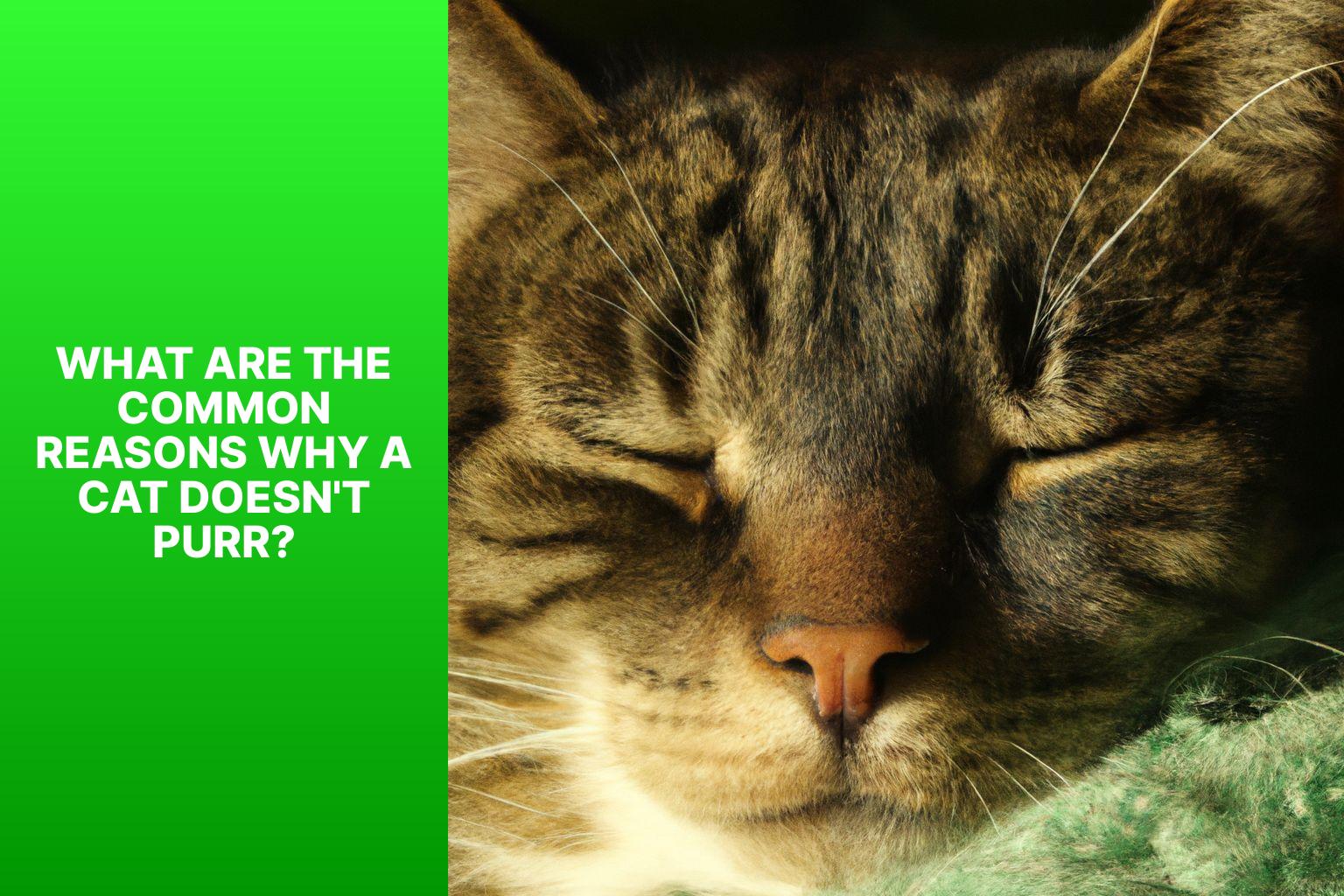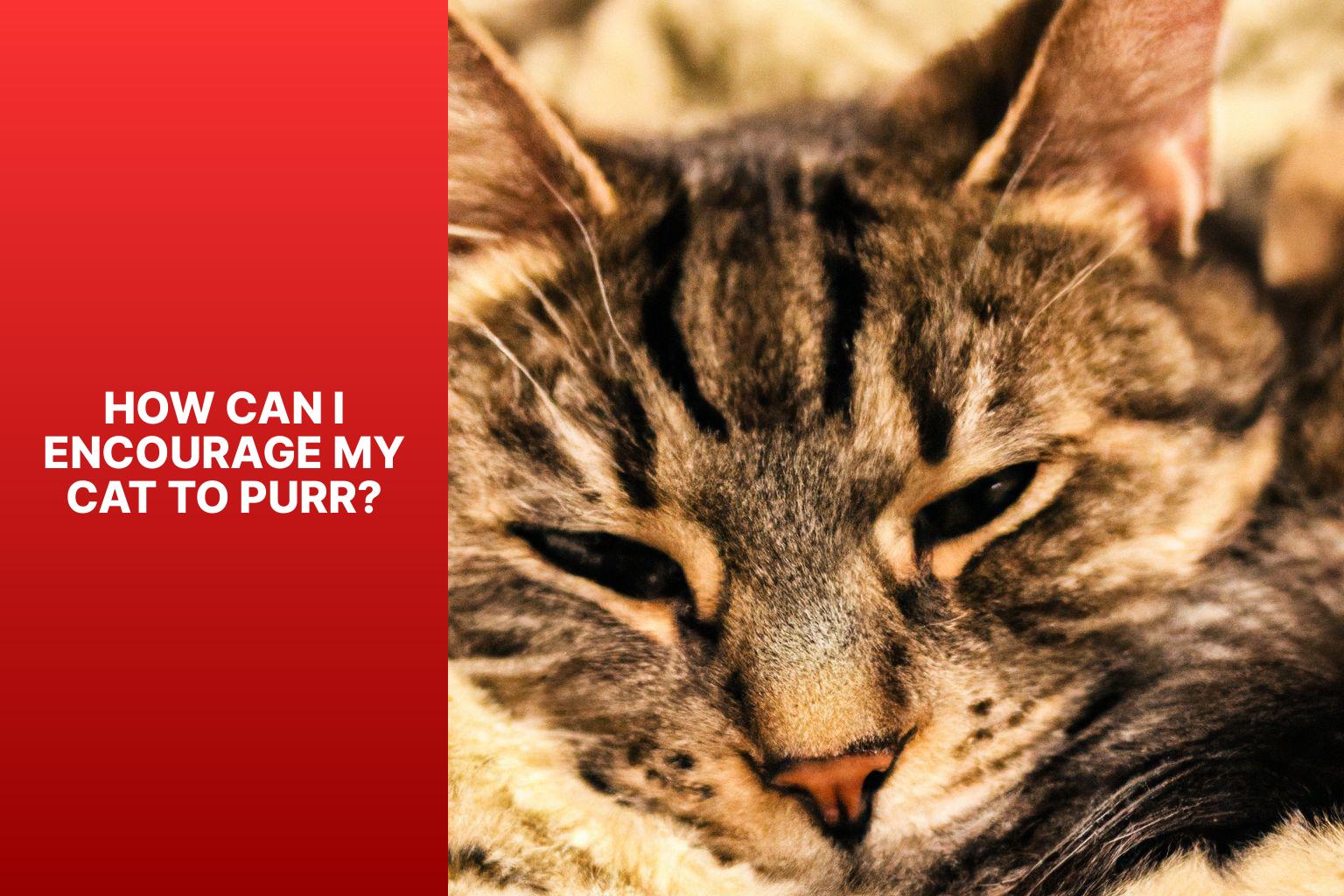Cats are known for their soothing and comforting purrs, which can bring a sense of calmness and contentment to their owners. There are instances when a cat may not purr, leaving owners wondering why. Understanding the phenomenon of cat purring and the reasons behind its absence can help shed light on this behavior.
Purring is a unique behavior exhibited by domestic cats, starting from their earliest days as kittens. The sound of purring is produced through the rapid vibration of the cat’s vocal cords while they inhale and exhale. This creates a distinctive purring sound that varies in intensity and pitch.
Cats purr for various reasons, and it’s important to acknowledge that each cat may have its own preferences and motivations. Purring is often associated with positive emotions and can serve as a form of communication.
Purring can indicate contentment, relaxation, and general satisfaction in a cat’s surroundings. It can also serve as a means of self-soothing in stressful situations and as a form of bonding between cats and their owners. Purring has been linked to the release of endorphins, which are feel-good hormones that can promote a sense of well-being in cats.
While purring is a common behavior in cats, there may be instances when a cat doesn’t purr as expected. Some potential reasons for a cat’s lack of purring include:
Stressful or anxiety-inducing situations can disrupt a cat’s ability to purr. Cats may withhold their purring if they feel threatened, scared, or are in an unfamiliar environment.
Certain medical conditions, such as respiratory problems or throat issues, can affect a cat’s ability to purr. If a cat is experiencing discomfort or pain in the vocal cord area, it may refrain from purring.
Just like humans, cats have their own unique personalities and preferences. While some cats may purr frequently and loudly, others may be more reserved and less inclined to purr. Factors such as genetics, early life experiences, and socialization can play a role in a cat’s purring behavior.
If you’re looking to encourage your cat to purr, there are several strategies you can try:
Ensuring that your cat feels safe, secure, and relaxed in its surroundings can encourage purring. Providing a peaceful and stress-free environment can help your cat feel more comfortable and content.
Physical touch, gentle strokes, and spending quality time with your cat can help foster a sense of companionship and trust, potentially leading to increased purring.
Observe and understand what activities, toys, or environments make your cat the happiest. Cater to your cat’s specific likes and needs to create an environment that promotes purring.
While the absence of purring alone may not always be a cause for concern, if your cat also exhibits other unusual behaviors, appears in pain, or shows a significant change in behavior, it may be a sign of underlying health issues. In such cases, it is advisable to consult with a veterinarian to ensure the well-being of your feline friend.
Key takeaways:
Key takeaway:
- Understanding cat purring: Purring is a way for cats to communicate their contentment and happiness. It is important to understand the meaning behind this behavior.
- Reasons why cats purr: Cats purr to show affection, relaxation, or to communicate their needs. Understanding the purpose of purring helps to build a strong bond with your feline friend.
- Common reasons for a cat not purring: Cats may not purr due to stress or anxiety, underlying medical conditions, or simply individual personality differences. Recognizing these reasons can help address any potential issues.
Understanding Cat Purring
Understanding Cat Purring
Cats purring is a fascinating behavior. It indicates various emotions or states of being. Here are some key points to understand cat purring:
- Cats purr when content and relaxed to express happiness and comfort.
- Purring helps cats calm themselves in stressful situations or when in pain.
- Cats may purr to communicate with their owners and seek attention or affection.
- Cats can purr at different frequencies, typically ranging from 25 to 150 Hertz.
- Some theories suggest that purring can help cats heal by stimulating tissue growth and repair.
True story: I had a cat named Whiskers who would purr whenever I played the piano. It seemed like the music brought her joy and relaxation. One day, Whiskers injured her paw and was visibly in pain. As I played a soothing melody on the piano, she came and sat beside me, purring throughout the entire session. It was heartwarming to see how the power of music and her purring provided her comfort during a difficult time. Understanding cat purring can deepen our bond with these incredible creatures and help us better care for them.
Why Do Cats Purr?
Cats purr for various reasons. Why do cats purr? Purring signals contentment and relaxation, expressing happiness and comfort. Cats also purr to seek attention or when they want something. Additionally, purring serves as a self-soothing mechanism for cats in stressful situations.
Interestingly, purring is not exclusive to domestic cats. Why do big cats like lions and cheetahs also purr? The exact reason for purring is still not fully understood. Scientists believe that purring involves the rapid contraction and relaxation of muscles in the larynx, creating the purring sound.
In a similar vein, my cat named Whiskers would purr incessantly when I was studying or working on my computer. It seemed like she knew how to provide me with calm and focus, boosting my productivity and enhancing my overall well-being. Having Whiskers nearby and hearing her purr instantly made me feel better when I was stressed or overwhelmed. It showcased the incredible bond between humans and their feline companions.
So, the mystery of why do cats purr continues. One thing is clear: purring is a beautiful and comforting sound that brings joy and tranquility to both cats and humans.
What Is the Purpose of Purring?
The purpose of purring in cats serves several important functions. What Is the Purpose of Purring? Cats purr to express contentment and relaxation, and to communicate with their owners and other animals. Purring is a social interaction that can be used to seek attention and affection. It also has healing properties, such as promoting bone growth, reducing stress-induced health issues, lowering blood pressure, and providing pain relief. Understanding the purpose of purring helps cat owners meet their cats’ needs, create a calm environment, offer affection and attention, and provide necessary care and treatment. So, when your cat purrs, it signifies contentment and happiness in your presence. Enjoy the soothing sound and embrace the advantages of your cat’s purring!
What Are the Common Reasons Why a Cat Doesn’t Purr?
Photo Credits: Www.Catcornerblog.Com by Gerald Carter
Ever wondered why your beloved cat doesn’t purr? Let’s explore the common reasons behind this intriguing behavior. From stress or anxiety to various medical conditions, and even the unique personality of your furry friend, we’ll uncover the factors that might affect a cat’s purring. Buckle up and get ready to dive into the fascinating world of feline communication and discover what could be hindering your cat’s soothing purrs.
Stress or Anxiety
Stress or anxiety can cause cats to not purr. Cats, like humans, can experience stress or anxiety in various situations. This can be due to changes in their environment, such as moving or the presence of unfamiliar people or animals. Cats may also feel stressed or anxious if they are not receiving enough attention or if they have had negative experiences in the past.
When a cat is stressed or anxious, their body releases stress hormones that can affect their behavior and well-being. This can result in a non-purring cat. They may show signs of restlessness, decreased appetite, hiding, or aggression. It is important to observe these behavioral changes and provide a calm and safe environment for your cat.
To help reduce stress or anxiety in cats, create a comfortable and appropriate environment. Provide hiding spaces, scratching posts, and interactive toys. Giving your cat affection and attention can also help them feel more secure and reduce stress. Understand your cat’s preferences and establish predictable routines to alleviate anxiety.
I had a cat named Whiskers who was anxious and rarely purred. He would hide under the bed when visitors came or when there were loud noises. I realized his lack of purring was a way to communicate his stress or anxiety. To help him feel more at ease, I created a safe space for him with a cozy bed and toys. I also gave him extra attention and playtime to help him relax. Over time, Whiskers became more comfortable and started purring during our snuggle sessions. It was rewarding to see him find contentment and express happiness through purring.
Medical Conditions
Medical conditions can prevent a cat from purring. Cat owners should be aware of these issues and seek veterinary care when necessary.
- Respiratory problems: Cats with asthma or upper respiratory infections may struggle to purr due to compromised airways.
- Neurological disorders: Cats with nerve damage affecting the muscles used for purring may be unable to make the sound.
- Injury or trauma: Any damage to the throat, vocal cords, or laryngeal muscles can interfere with a cat’s ability to purr.
- Pain or discomfort: Cats in pain or discomfort may not purr as their focus is on managing their discomfort rather than making the soothing sound.
- Other medical conditions: Cats with hyperthyroidism, kidney disease, or cancer may experience changes in purring behavior due to their underlying illnesses.
If a cat is not purring and shows signs of illness or discomfort, it is important to consult a veterinarian for proper diagnosis and treatment. Prompt medical attention can address the underlying condition and restore the cat’s ability to purr.
Personality and Individual Differences
1. Cats have unique personalities that vary greatly among individuals.
2. Some cats are more outgoing and sociable, while others are more shy and reserved.
3. Personality traits such as curiosity, aggression, and affection also differ among cats.
4. These differences are shaped by genetics, early experiences, and environmental factors.
5. Understanding and appreciating these differences is important for cat owners to provide the best care and support.
6. Some cats prefer quiet and solitude, while others thrive in a busy household.
7. Understanding your cat’s personality helps create an environment that suits their needs.
8. Personality and individual differences can influence a cat’s communication style.
9. Some cats communicate vocally, while others use body language and facial expressions.
10. By observing and understanding these differences, cat owners can better communicate and bond with their feline friends.
Pro-tip: Observe and get to know your cat’s unique personality to provide the best care and build a strong bond with them.
How Can I Encourage My Cat to Purr?
Photo Credits: Www.Catcornerblog.Com by Bradley Brown
Want to know how to make your cat purr? Let’s uncover tips and tricks to encourage those soothing vibrations from your feline friend. From creating a calm and safe space to understanding your cat’s preferences, we’ll explore ways to cultivate an environment in which purring becomes second nature. Give your cat the love and attention they crave, and soon you’ll have a contented kitty sharing their joy with a relaxing purr.
Creating a Calm and Safe Environment
Creating a calm and safe environment is crucial for your cat’s well-being. Here’s how to achieve this:
1. Provide a designated space: Set up a cozy and quiet area in your home where your cat can go for some peace and quiet. This could be a comfortable bed, a cat tree, or a hiding spot.
2. Minimize noise and disturbances: Cats are sensitive to loud noises and sudden movements. Keep the environment calm by reducing noise levels and avoiding disruptions.
3. Control the temperature: Make sure your home is a comfortable temperature for your cat. Avoid extreme heat or cold, and provide cozy blankets or heating pads in colder months.
4. Secure the environment: Cats can be curious and may explore unsafe areas. Cat-proof your home by closing windows and doors securely, covering electrical cords, and removing toxic plants or substances.
5. Provide vertical and horizontal spaces: Cats love to climb and explore. Offer them cat trees, shelves, and play areas to meet their natural instincts.
6. Offer hiding places: Some cats enjoy having secluded spots where they can observe without feeling exposed. Provide covered beds or cardboard boxes as hiding places.
Creating a calm and safe environment will make your cat feel more secure, relaxed, and will strengthen your bond. Remember to observe your cat’s behavior and preferences to tailor the environment to their specific needs.
Giving Your Cat Affection and Attention
When giving your cat affection and attention, it is important to consider these factors: snuggling for bonding, providing fresh water for hydration, engaging in interactive playtime for mental and physical stimulation, and creating a calm and safe environment with a cozy bed, scratching post, and quiet space. These actions strengthen your bond and contribute to your cat’s happiness and well-being.
Understanding Your Cat’s Preferences
To understand your cat’s preferences, pay attention to their likes and dislikes. Cats have discerning tastes and individual quirks, so getting to know their preferences strengthens your bond and ensures their happiness.
1. Food Preferences: Cats can be picky about their food. Some prefer wet food, while others prefer dry kibble. Experiment with different flavors and textures to find what your cat enjoys most.
2. Sleeping Preferences: Cats love cozy places to nap. Provide cat beds, blankets, or cozy nooks. Observe where your cat naturally rests and make sure they have access to that spot.
3. Playtime Preferences: Cats have different play styles. Some prefer interactive toys, while others enjoy laser pointers or feather wands. Pay attention to what engages your cat the most.
4. Scratching Preferences: Cats need to scratch to keep their claws healthy and mark their territory. Offer scratching surfaces like cat trees, posts, or cardboard scratchers. Observe if your cat prefers vertical or horizontal surfaces.
5. Litter Box Preferences: Cats are particular about their litter box. Provide a clean, easily accessible box in a quiet location. Experiment with different types of litter to find what your cat prefers.
By understanding and catering to your cat’s preferences, you can create an environment tailored to their needs, ensuring their happiness and well-being. Remember, each cat is unique, so observe and adjust accordingly for the best experience.
When Should I Be Concerned if My Cat Doesn’t Purr?
When should I be concerned if my cat doesn’t purr?
When a cat does not purr, it could be a cause for concern. Cats purr to express contentment, relaxation, and sometimes to communicate with their owners. If a cat suddenly stops purring, it could indicate an underlying health issue.
One potential reason for a cat’s lack of purring is pain or discomfort. Cats often purr to self-soothe and alleviate pain. If a cat is not purring and shows signs of discomfort, such as limping or reluctance to move, it’s important to consult a veterinarian. They can assess the cat’s condition and provide appropriate treatment.
Another reason why a cat may not be purring is stress or anxiety. Cats can experience stress due to changes in their environment, such as a move or the introduction of a new pet. If a cat’s behavior has changed and they no longer purr, it could be a sign of stress. Providing a calm and secure environment and engaging in interactive play can help alleviate their anxiety.
If a cat has never purred before, it could indicate an underlying health issue or simply be a personality trait. Some cats do not purr as frequently or as loudly as others.
Some Facts About Why Cats Don’t Purr:
- ✅ Not all cats can purr due to anatomical variations or abnormalities in the vocal cords or nervous system. (Source: Our Team)
- ✅ Cats may communicate in other ways and choose not to purr as a means of expressing themselves. (Source: Our Team)
- ✅ Feral cats, due to their wild origins, may not purr as much as domesticated cats. (Source: Our Team)
- ✅ Cats may not purr if they are sick, stressed, or experiencing pain. (Source: Our Team)
- ✅ Some cat owners may not hear their cats purring even though the cat is actually purring. (Source: Our Team)







